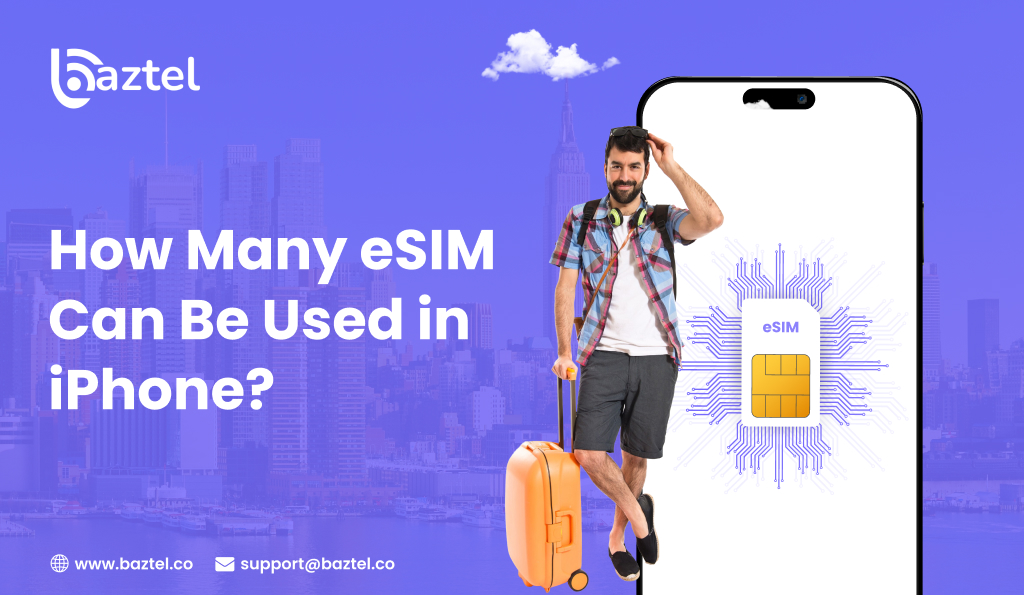Five years ago, eSIM sounded like a cool tech feature only a few people used. Today, it’s slowly becoming the new normal and in 2025, we’re seeing that shift play out in real time.
People no longer want to wait for a physical SIM or hunt for a store abroad. Travelers want instant data when they land. Businesses want easier control over devices. And smartphone users? They just want to tap, scan, and connect.
That’s why the future of eSIM looks bigger than just phones. From smartwatches to cars, laptops to logistics, eSIM is quietly powering how we stay connected without plastic, pins, or delays.
In this blog, we’ll break down the top eSIM trends shaping 2025 and what’s coming next. Whether you’re a traveler, developer, or just a curious user, this guide will help you stay ahead of the curve.
If you’re new to this, here’s a quick breakdown of what an eSIM is and how it works before we dive into the future.
Future of eSIM in 2025: What changed and why it matters
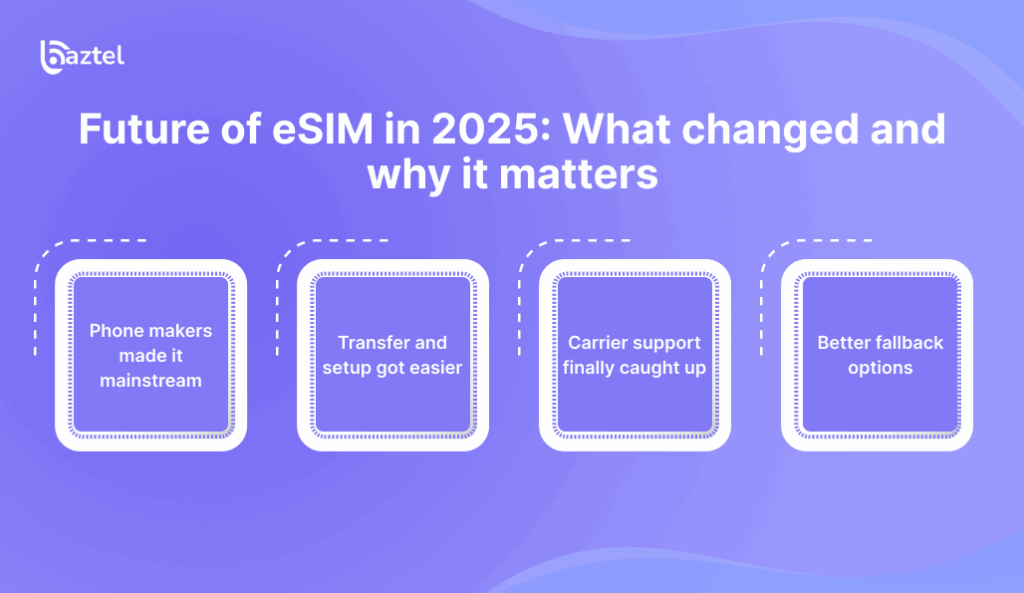
If you’ve used an eSIM before, you know the basics: scan a QR code, activate the plan, and you’re online. But in 2025, that experience has gone from “nice to have” to something users now expect by default.
Here’s what changed:
- Phone makers made it mainstream: Apple dropped the SIM tray from iPhones in the US long ago, and now more Android brands are doing the same. New launches in 2025 come with better eSIM support, even in mid-range phones.
- Transfer and setup got easier: Earlier, moving eSIMs between phones felt confusing. Now, Android and iOS both support smoother eSIM transfers. No need to call customer care or scan a QR again. Your new phone can pull the eSIM directly.
- Carrier support finally caught up: Big telecom companies have improved their eSIM onboarding flows. Many now offer app-based activation in minutes, and even local providers in Asia, Africa, and South America are jumping in.
- Better fallback options: Lost your phone? Some carriers now let you recover your eSIM remotely or reissue it to a new device. This wasn’t always possible before.
Why does this matter? Because it removes the friction. Earlier, eSIM adoption was held back by poor support and setup hurdles. But with these changes, the gap between eSIM and physical SIM is practically gone.
The result? More users now try it, like it, and stick with it.
Trend 1: More phones go eSIM-first, some go eSIM-only
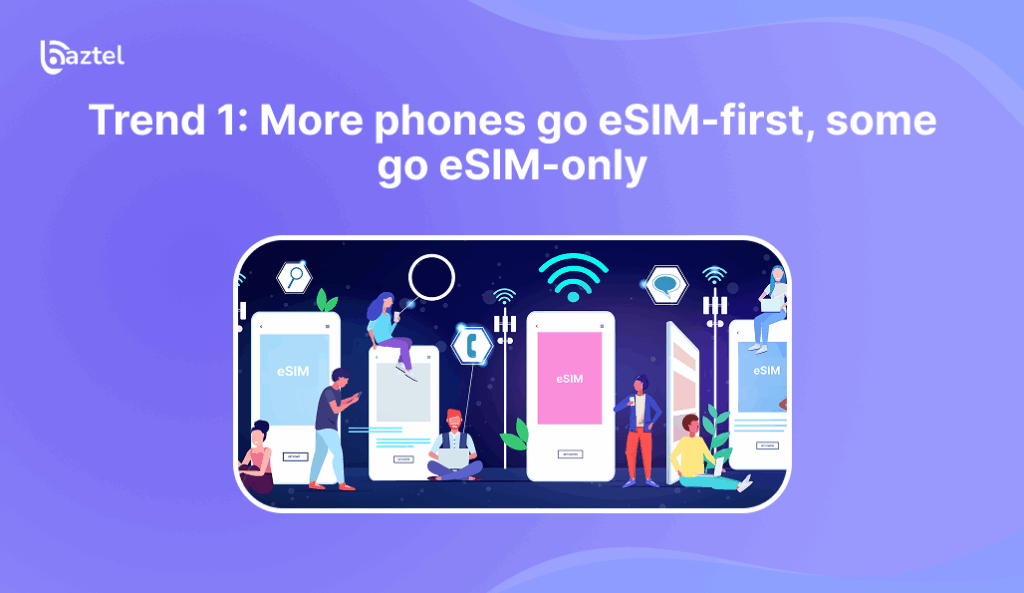
The biggest push behind the future of eSIM is coming straight from the brands we hold in our hands phone makers.
In 2025, it’s not just about Apple anymore. Several Android manufacturers have joined the eSIM-only movement, at least in a few regions. And many others are now launching devices where eSIM is the default option, even if a physical SIM slot is still there as backup.
Android phones now support smoother eSIM transfers — you no longer need to scan a QR or call support. Here’s how to transfer eSIM between Android devices.
Apple’s push sped things up
When Apple removed the SIM tray from iPhones in the US, it shook up the market. At the time, it felt risky. But now, it looks like a smart bet. Carriers had to adapt quickly. eSIM activation got faster. And people who hesitated earlier started giving it a try mostly because they had no choice.
That move made eSIM support a must-have, not just a nice-to-have.
Android closes the gap with easier eSIM transfers
On the Android side, Google, Samsung, and others now offer eSIM transfer tools. Earlier, switching phones meant scanning a QR again or calling customer care. But in 2025, many Android phones let you move eSIM plans directly during setup.
It’s not perfect everywhere. Some regions and carriers still lag. But compared to 2022–23, things are far smoother now.
Bottom line? Physical SIM cards are slowly getting replaced. Not overnight, but one model at a time.
Trend 2: Travel eSIM becomes the default way to roam
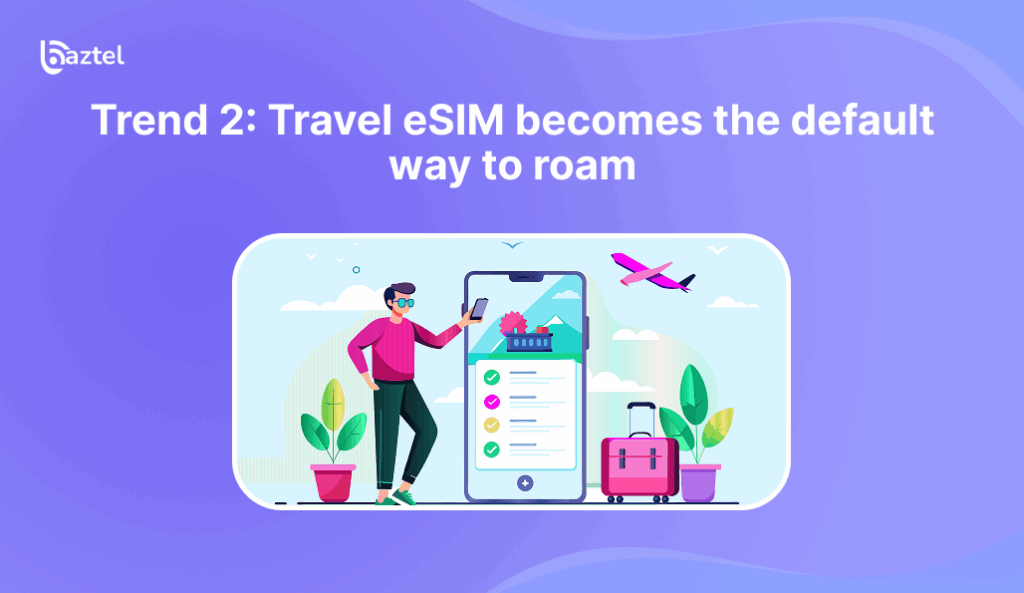
Ask any frequent traveler in 2025, and you’ll hear the same thing: “I don’t bother with local SIMs anymore.” That’s because travel eSIMs have gone from niche to normal, especially for people moving between countries. Most travelers now prefer travel eSIMs in Europe over physical SIM cards, especially for speed and no paperwork.
For international trips, these best eSIM plans for travel offer prepaid data, local carrier support, and no hidden roaming fees.
You no longer have to visit kiosks, share your passport, or get stuck with roaming charges. Just open an app, choose a country, and activate a data plan in under five minutes.
This shift is one of the biggest real-world changes driving the future of eSIM.
Instant setup, local-like rates, and fewer surprises
Most travel eSIM providers now offer prepaid data plans with transparent pricing. You see how much data you’ll get, what it costs in USD, and how long it lasts all before you pay. No hidden fees. No confusing contracts.
Also, because these plans use local carriers in the country you’re visiting, the speed and stability are often better than international roaming. You’re not stuck on slow backup networks.
Better cross-device account handling
Another 2025 upgrade? You can now manage your eSIMs from multiple devices under the same account. That means you can buy it on your laptop, install it on your phone, and even share it across family members using app-based dashboards.
And if your trip gets delayed or cancelled, many providers now let you pause or push your eSIM to a later date, something unheard of a few years ago.
This makes eSIM a smart, flexible option not just for techies, but for casual travelers too.
Trend 3: eSIM for wearables, cars, and smart devices grows fast
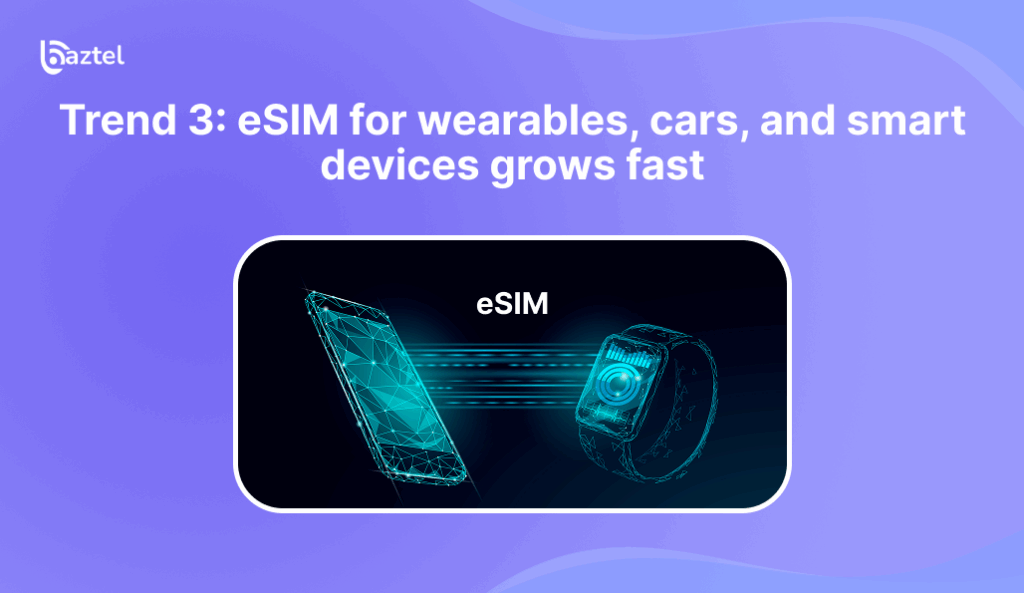
The future of eSIM is no longer just about smartphones. In 2025, it’s spreading into smartwatches, connected cars, tablets, and even home appliances. Anything that needs a SIM but doesn’t have space for one is now going the eSIM route.
Smart devices need to stay small, power-efficient, and always connected. That’s where eSIM fits perfectly.
Unlike physical SIM cards, eSIMs make it possible to fit mobile connectivity into tiny wearables without adding bulk.
The new GSMA IoT standards unlock scale
In the past, getting eSIMs into non-phone devices was tricky. You needed complex provisioning, and each device type needed custom support. But in 2025, new GSMA standards have simplified this.
Now, manufacturers can pre-burn eSIM profiles and let users activate or change plans remotely even after the device is sold. This makes it much easier to scale eSIM across thousands or even millions of IoT devices.
Wearable makers love this because it keeps their devices compact and waterproof. Car makers are adopting eSIM for built-in GPS, live traffic updates, and in-car Wi-Fi.
5G RedCap and eRedCap bring low-power 5G to life
Another game-changer: 5G RedCap (Reduced Capability) and eRedCap.
These are new versions of 5G built for low-power devices like smartwatches, medical sensors, and vehicle trackers. When paired with eSIM, they deliver high speed and low latency without draining the battery.
So in 2025, your fitness band, kid’s GPS tracker, or electric scooter may quietly be running on eSIM and 5G RedCap without you even knowing.
This is how eSIM is silently shaping the connected world around us.
Learn more about what 5G RedCap is and its use cases — the lightweight, battery-efficient 5G suited for wearables and compact IoT gadgets.
Trend 4: iSIM steps in for ultra-small, low-power devices
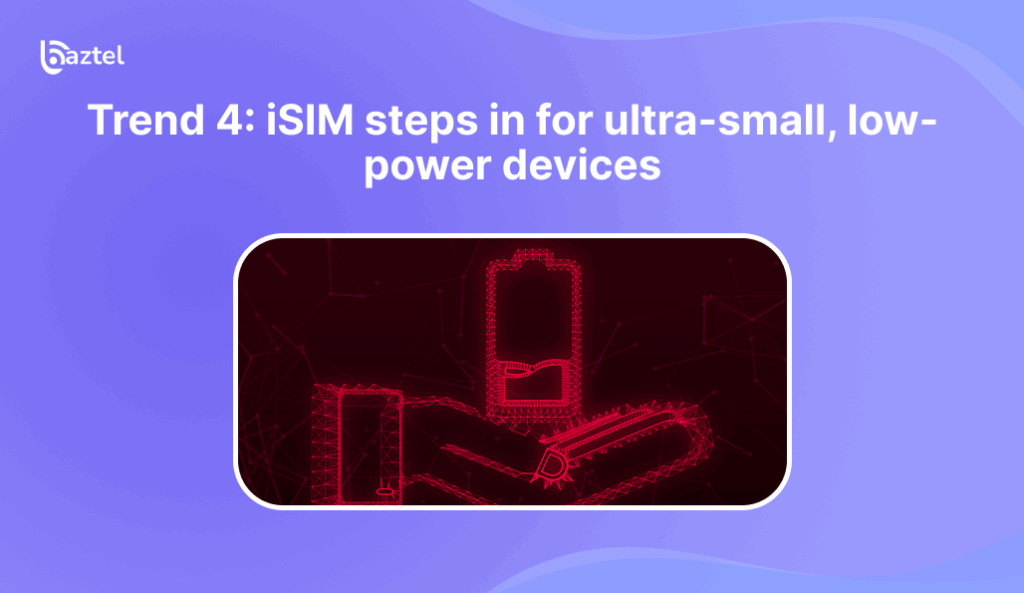
If eSIM removes the need for a physical SIM card, iSIM goes a step further it removes the need for a separate SIM chip altogether.
In iSIM (integrated SIM), the SIM functionality is baked right into the device’s main processor. That means one less component, lower power usage, and more space inside the gadget. And in 2025, we’re seeing iSIM make its way into real-world use cases.
So how is this different from the future of eSIM? Think of iSIM as a cousin to eSIM built for the tiny, battery-saving world of IoT.
Smart meters, industrial sensors, fitness wearables, asset trackers, these devices can’t afford extra chips or complex wiring. That’s where iSIM fits in.
It’s secure, light, and can be deployed at scale with remote provisioning. The end user doesn’t have to do anything. The device just works out of the box, with mobile connectivity already active.
In the next few years, expect to see iSIM quietly power millions of background devices you never think about but rely on every day.
Unlike eSIMs, which require a dedicated chip, iSIM has no separate module — making it even smaller than what we see in pocket WiFi vs eSIM comparisons.
Trend 5: Enterprise eSIM management gets simpler
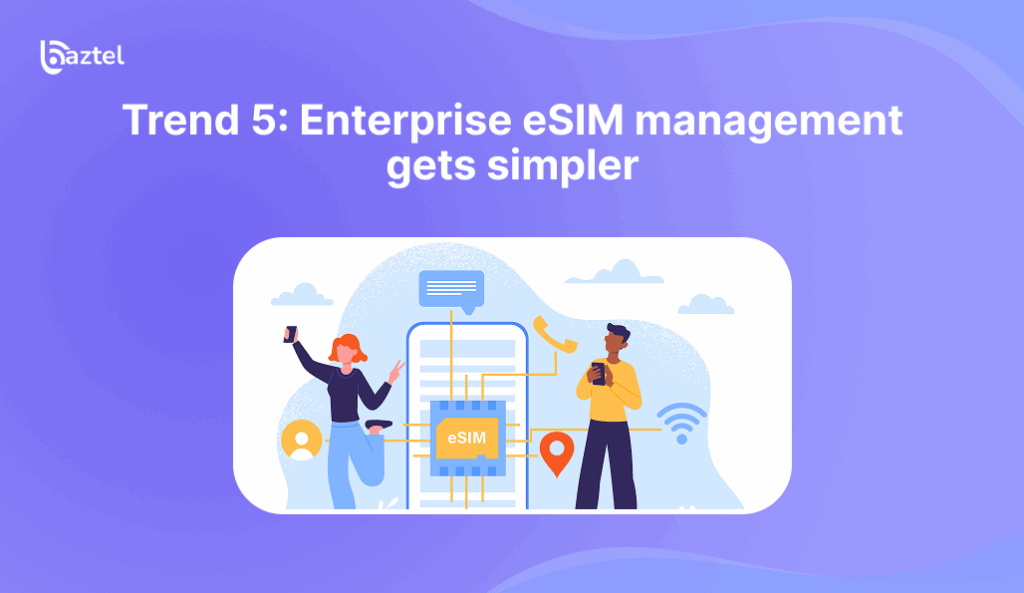
For businesses managing dozens or hundreds of devices, eSIM once felt like more trouble than it was worth. Too many activation steps. Too much manual handling. Not enough control.
But in 2025, that story has changed and it’s a key reason why the future of eSIM now includes serious traction in the enterprise world. Businesses operating across borders can now use global eSIM plans to manage devices with a single console.
Provision, pause, or switch plans from one console
Modern eSIM platforms now offer centralized dashboards. Think of it like a control room where IT teams can assign plans, activate eSIMs, or pause a number when an employee leaves without needing to touch the device.
It’s helpful for remote teams, field agents, logistics fleets, and even tablet-based POS systems in retail.
Some platforms even support bulk eSIM activation using QR batches or preloaded profiles so devices arrive ready to work out of the box.
Security, compliance, and audits improve
In 2025, more eSIM providers are building tools for compliance and reporting. You can see which device used how much data, when a SIM was activated, and which plans are nearing expiry.
This matters for industries like healthcare, finance, and logistics where mobile data usage is tied to regulations and cost control.
Add in remote wiping, plan switching, and profile locking, and eSIM becomes a much more powerful option for businesses than a traditional SIM card ever was.
If your company uses remote agents or a traveling team, explore how businesses are using eSIM to improve control and reduce cost.
Trend 6: 5G Standalone, slicing, and smarter roaming meet eSIM
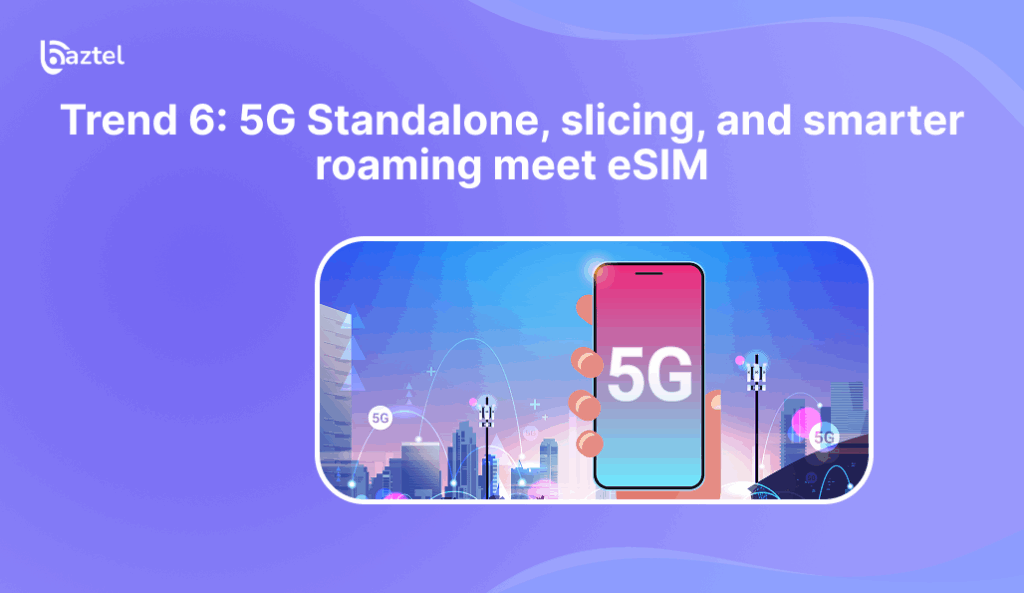
As 5G matures, it’s no longer just about speed. In 2025, we’re seeing 5G Standalone (SA) rollouts accelerate and it pairs perfectly with the future of eSIM.
What’s different about 5G SA? It allows advanced features like network slicing, where carriers can create custom “lanes” for different types of traffic. For example, a medical device can get a slice optimized for low latency, while a logistics tracker gets one tuned for stability.
eSIM fits right into this model because it lets users (or devices) switch between slices or plans without changing hardware.
Also, roaming is finally getting smarter. With eSIM, your phone can store multiple profiles and automatically switch to a better local carrier when abroad. This reduces dropped calls, improves speed, and cuts costs especially for frequent travelers or remote teams.
eSIM gives 5G a flexible backbone. Together, they open the door for personalized plans, real-time switching, and better network control all without touching the SIM slot.
Smarter roaming with auto-switching makes eSIM better than traditional roaming in both performance and cost.
What this means for everyday users in 2025
So what does all this progress really mean for the average phone user, traveler, or smartwatch owner?
Simply put, less waiting, more control.
You no longer have to go to a store to get a SIM. No more struggling with tiny trays. And no more roaming shock after a short trip abroad. With the future of eSIM, you can:
- Activate your mobile plan from home
- Switch carriers if you find a better deal
- Add a travel plan just before boarding your flight
- Use the same number across phone, watch, and tablet
- Share data across devices in your family
Even better if your phone is lost or stolen, you don’t lose your SIM. You can lock it remotely and reissue it on a new phone.
And if you’re someone who uses dual SIM for work and personal lines, eSIM makes it easier to manage both from the same phone without carrying two devices.
eSIM is no longer about “cool tech”. In 2025, it’s just a smarter way to connect.
What this means for businesses and IT teams
The future of eSIM is opening up new ways for businesses to manage their mobile devices. In 2025, it’s not just about phones it’s about flexibility, control, and cost savings across entire teams.
Let’s say your company has 100 field agents, each using a phone or tablet. With eSIM:
- You don’t need to order and ship physical SIMs
- You can activate, suspend, or switch plans remotely
- You can assign local eSIMs when your staff travels abroad
- You reduce downtime when a device gets damaged or replaced
- You control costs by monitoring data usage in real time
For startups, it means faster onboarding new employees can get a working number within minutes, no matter where they are.
For larger enterprises, it means better compliance. Admins can now track SIM activity, set expiry rules, and even revoke access all from a central console.
And for IT teams managing multiple devices (phones, watches, even smart tags), eSIM offers one big win: zero physical handling.
Everything runs on software. Everything is trackable. Everything is scalable.
Buying advice in 2025: How to stay ready for the future of eSIM
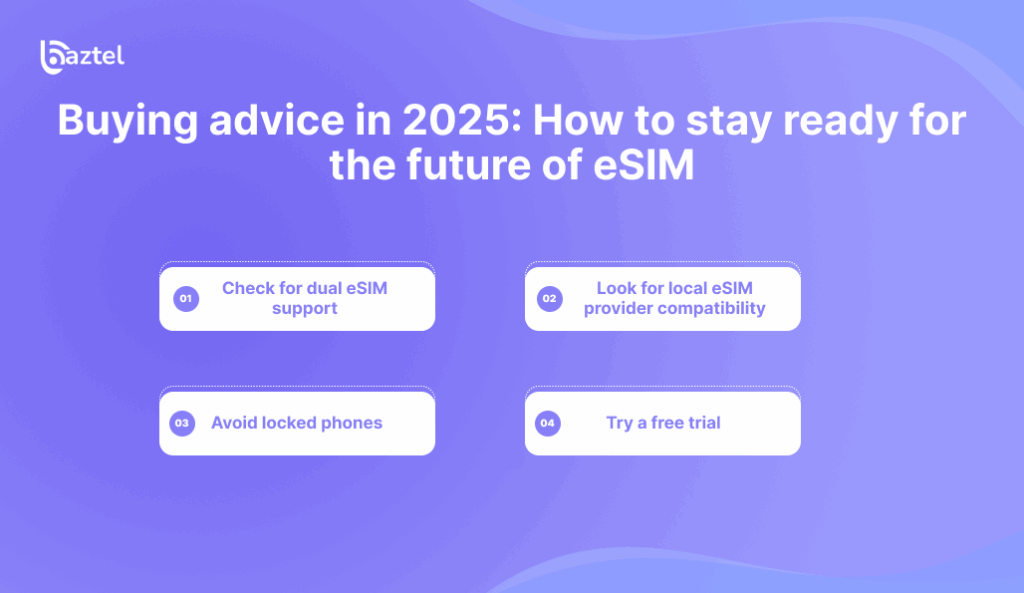
If you’re planning to buy a phone, tablet, or smartwatch in 2025, it’s smart to check how well it supports eSIM. The future of eSIM is already here and choosing the right device now can save you time, stress, and money later. Some carriers now offer a free eSIM trial — it’s a great way to test coverage before paying.
Here’s what to look for:
- Check for dual eSIM support: Many phones now offer support for two active eSIMs. That’s useful if you want to keep work and personal lines separate, or if you need a local eSIM while keeping your home number active. If you’re unsure whether your destination is supported, use Baztel’s eSIM coverage checker to confirm before you travel.
- Look for local eSIM provider compatibility: Before traveling, see if your destination has reliable eSIM support. Sites like GSMArena and Apple’s carrier list show which carriers work with eSIM.
- Avoid locked phones: Some phones sold through carriers are still locked, meaning you can’t easily use third-party travel eSIMs. Buy factory-unlocked models to stay flexible.
- Try a free trial: Some providers now offer free eSIM trials. It’s a great way to test coverage and speed without paying upfront.
Buying with eSIM in mind ensures your device stays relevant as global networks evolve and it puts you in control of how you connect. If you’re still using a physical SIM, here’s how to convert it to eSIM safely without losing your number.
Conclusion: The future of eSIM is practical, not hype
eSIM is no longer just a tech buzzword. It’s already changing how we use our phones, manage devices, and stay connected. Whether you’re a casual traveler or a digital nomad, having international eSIM coverage is now easier and more flexible than ever.
In 2025 and beyond, the future of eSIM looks simple, secure, and scalable. You’ll see fewer plastic SIMs, fewer trips to the store, and more power in your hands. From dual eSIM phones to iSIM-powered gadgets, the entire mobile ecosystem is moving toward software-first connectivity.
If you haven’t tried an eSIM yet, now’s a good time. Start with a travel plan. Test it on a spare device. Or switch your primary number if your phone allows it.
The real power of eSIM isn’t about flashy features, it’s about making connectivity feel easy, instant, and invisible.
FAQs
Q1. What is an eSIM and how is it different from a regular SIM?
An eSIM is a digital version of a SIM card that’s built into your device. You don’t need to insert anything physically, just scan a QR or activate it from your carrier’s app.
Q2. Can I use eSIM on dual SIM phones?
Yes. Most modern phones support dual SIM either one physical SIM and one eSIM, or dual eSIMs. You can use two numbers on the same device.
Q3. How do I switch my existing number to an eSIM?
If your carrier supports it, you can convert your physical SIM to an eSIM through their app or by scanning a QR code they send you. The steps may vary by provider.
Q4. Is eSIM safe to use while travelling?
Absolutely. eSIM is secure, and you can use travel-specific data plans without replacing your home number. It also lets you switch plans instantly if you need more data. Learn how eSIM keeps your data secure — especially if your phone is lost or stolen while abroad.
Q5. What happens if I lose my phone with an eSIM?
You can contact your carrier to deactivate or transfer your eSIM remotely. Some apps also let you lock the number or move it to a new device from your account.
Blog Author
Peter
Peter started BazTel.co to make mobile internet easier for travellers. He noticed how tough it was to find good network options while visiting new countries. That’s when he built BazTel — a place where anyone can buy eSIMs online without confusion or long steps. He believes tech should be simple and useful, not complicated. When he’s free, he likes to travel, test BazTel himself, and keep improving it based on real user problems.

 Botswana
Botswana Zambia
Zambia Congo
Congo Colombia
Colombia China mainland
China mainland Chile
Chile Chad
Chad Central African Republic
Central African Republic Canada
Canada Cameroon
Cameroon Cambodia
Cambodia Burkina Faso
Burkina Faso Bulgaria
Bulgaria Brunei Darussalam
Brunei Darussalam Brazil
Brazil Aland Islands
Aland Islands Bosnia and Herzegovina
Bosnia and Herzegovina Bolivia
Bolivia Belgium
Belgium Belarus
Belarus Bangladesh
Bangladesh Bahrain
Bahrain Azerbaijan
Azerbaijan Austria
Austria Australia
Australia Armenia
Armenia Argentina
Argentina Algeria
Algeria

